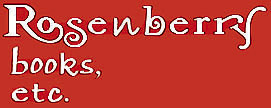“A package of oatmeal all in black with typography redolent of a nineteenth-century circus poster might be a splendid piece of graphic design but would most likely confuse someone just looking for breakfast.”
— On Book Design by Richard Hendel
Thank you Richard Hendel for a perfect introduction to the subject of this column: typographical “expression.”
Once upon at time, Dave Russo of the North Carolina Haiku Society showed me a small stack of books from his haiku collection. He hoped to stimulate discussion about how we might design Beneath the Willow Tree, an NCHS anthology. I opened one volume and immediately queried, “Is this a children’s book?”
It was not. It was a book of haiku and photographs for adults. The typography and layout, however, followed common children’s book design: on every spread a short text in a very large point size was opposite an illustration.
As I read, it took some effort on my part to resist the context and to appropriately “hear” the haiku. The moral of this story is contained in the quote above: if you want to inspire appetite, don’t design an oatmeal box that conjures the smell of elephants and greasepaint.
We live in a world of loud, dynamic and varied advertising. Can we pull back from this flashy world to notice how astonishingly subtle things affect us, whether we notice consciously or not?
Can we pull back from this over-stimulating world to read a haiku? Haiku poets, as they write, often make a special effort to get themselves out of the way in order to create poems without obstacles to the reader’s own experience. Typography and book design should be handled with the same sensitivity.
Our computers provide us with a baffling array of typographical choices. But something so simple as selection of bold or italicized fonts can have huge effects.
Here is another story. Somewhere I saw an anthology of haiku. The editors had the problem of identifying the author of each haiku. They chose to follow each poem closely with the author’s name, and in order to separate the name from the body of the poem, the author’s name was in bold. Typographically speaking, this amounted to shouting the author’s name. It emphasized the name. The name became more important than the poem.
To me, this design said that the editors encouraged readers to skim for the names of authors they knew. And for me, with the poet’s name shouting beneath each poem, I had a difficult time reading each haiku in peace. I know, I know, I’m just too sensitive. (But I know you are sensitive too, or you wouldn’t be writing all those marvelously tiny poems!)
With this column, I hope I am sending you back out in the world with something new to observe as you journey through books and publications — how does typographical expression assist or interfere with each reading experience?
“Typography Tips for Poets,” a column in Moonset Literary Review, was written by
Diane Katz, book designer, Rosenberry Books
Diane can be reached at 800.723.0336 diane@rosenberrybooks.com



